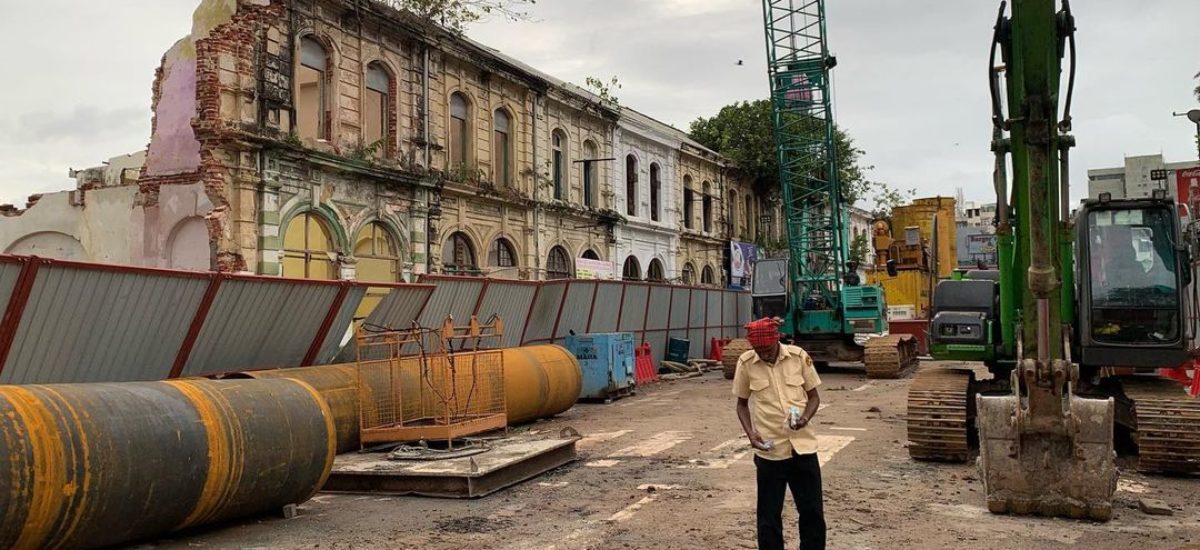Photo courtesy of Zeeshan Akram Jabeer
As elegant old buildings and diverse neighbourhoods disappear before our eyes, sacrificed on the altar of development, a group of people came together in 2018 to initiate the We Are From Here project in Slave Island, starting with an interactive mural composed as a memory building process together with residents. Since the project began, several of the neighbourhood’s iconic sights such as the Castle Hotel and de Soysa building have been razed to the ground or collapsed due to neglect. Malay Street and Java Lane look very different today, bulldozers are perennially dotting the area and inhabitants who have sustained this multi-ethnic neighbourhood over generations live in constant fear of eviction notices.
The group has collected souvenirs, picture albums and heirlooms left behind, sold away as scrap, gifted and donated, accompanied by sound recordings with community members to build an archive that not only narrates of dispossession and displacement but also brings recognition to philosophies of pluralistic living, forgotten stories, minor historiographies and tales of places that no longer exist.
As part of the project that was highlighted in Colomboscope 2022, a documentary, If These Walls Could Speak, was written and directed Zeeshan Akram Jabeer and produced by GIZ. It exposes the consequences of displacement and identity discontinuity following the emotional conflict of urbanisation across the culturally diverse and everchanging landscape of Slave Island.
Centered around the 150-year-old de Soysa Building and its residents, the latest in the long line of victims to the ever-changing landscape of Slave Island in the name of development, the film examines effects of urbanisation, displacement and dispossession and explores the slow burn repercussions it has on cultural values, identity and histography while drawing parallels between history and memory.
Zeeshan answers questions from Groundviews about what motivated him to make and film and what it conveys.
What motivated you to do this documentary?
Like everyone else, I was oblivious to what was happening in Slave Island. The rate and the scale at which urbanisation was swallowing this suburb wasn’t something you generally come across every day. When I spoke to Firi Rahman and the rest of the team of We Are From Here, I witnessed firsthand the atrocities that were often carried out in the name of beautifying Colombo. If These Walls Could Speak is an effort to give voice to the voiceless, create awareness and bring to light the repercussions of such events.
What are the challenges you faced?
As for challenges, COVID-19 wasn’t kind to our production and islandwide lockdown took about three to six months of shooting giving us a very small window. Also given the uncertainty of if we’ll ever be able to shoot the de Soysa building before it got demolished always kept me on the edge as a director. What’s worse is not being able to finish what you started or even tell the most authentic story possible. On the other hand, when we did get to shoot we weren’t welcomed by most residents of the de Soysa building due to contractual obligations nor were we welcomed by the officials by the Urban Development Authority, to whom it seemed like we were on the verge of uncovering a socio-economical conspiracy. The basis of the film was rooted in good old-fashioned guerrilla filmmaking, which in my opinion elevates the stakes and the sense of realism that the audience from the first few screenings we had seen to love.
What made that building special?
From what I learned from the research and from speaking to the people in the neighborhood, the de Soysa building given its larger-than-life scale failed to have a similar effect on people’s lives, it was just a building with a lack of fond memories attached to it. The same can’t be said about the residents of the building, some of them at least hold the building very dear to them, to them it’s legacy, memories and a place to truly call home but to the rest, it’s just a means to an end. These mixed feelings I feel also led to the demise of the building.
What kind of residents lived there?
The building housed many families, some of them living there for over 90 years spanning over four generations but some didn’t respect or even honour the heritage of the building. It was poorly taken care of as it was solely up to the residents and not the owners of the building, who never got involved until it was sold. In its prime, the building housed many shops and businesses;back in 2018, which was the last few years, it was lively. Until the demolition, a huge portion of the building was abandoned and sometimes occupied by squatters and drug peddlers. Slave Island has always been a melting pot of cultures and tightly knit communities, which is sadly being wiped away year after year. The Malay community is slowly being scattered across Colombo due to evictions and forced relocation.
Who is a colourful character who lived in the building?
If I were to describe one person specifically that completely moved me, it would be the late Noor Zulsky Passela, a thirdgeneration resident of the de Soysa building. Zulsky dedicated the last few years of his life fighting for this building that many families called home, day and night restlessly slaving away with the hope that the courts would appeal in their favour. That sense of belonging and dedication really took me aback and showed the lengths someone could go for something they believed in against all adversity. I was grateful to meet him and include him in the documentary; little did I know he wouldn’t get to see the film, which still remains something I feel guilty about. All the residents and shops have been relocated to the Tata Complex where Java Lane used to be.
Why preserve crumbling buildings on valuable land that can be put to better use?
That can easily be told but the real question is for the better use of whom? To the general public from whom these lands are being snatched from or to the foreign investors that are wiping away generations of culture and heritage for shiny buildings? Does better use mean that as a nation you give everything up to be whitewashed and identityless? The last time this happened a nation fought back and gained independence. It’s the same, history repeats itself if we don’t learn from our mistakes.
Is it a losing battle to preserve old buildings in Colombo?
It is already a battle lost, in my opinion. It’s a loss of culture, identity, history and memory. Even though If These Walls Could Speak is primarily a film about the effects of displacement and the emotional conflict following the urbanisation, centred around the magnanimous de Soysa building, in its true essence it’s a story about the people, a window to their soul if you may. I was very keen on not making a film about glorifying a building or an area but a film about the people, their lifestyle, and culture that makes a place what it is, that gives it meaning and therefore value.
How can a film such as yours make an impact?
As humans, we bleed emotions and that really shows in stories like this. There were instances in the film, where I deliberately let the camera keep rolling a few seconds more as the interviewees conveyed their most heartfelt and emotional thoughts. I could be biased but something like that is most effectively captured through this medium, most of the interviews are so beautifully poignant, it makes the weight of their suffering yours. I think that’s the beauty of it at the end of the day, you can take everything away from a person, their religion, culture and everything that contributes to their sense of identity but humans always have a way of making any place home.
How did making it change you as a person?
I think with every film, as a filmmaker you come out a different person. The people you have the pleasure of working with, telling their stories; may it be happiness, sorrow, grief and turmoil, in a way they become yours. These facets become a piece of you, it’s beautiful in a way. The ability to live a thousand lives and tell a thousand stories is truly a gift.


